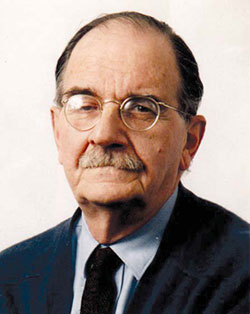from ISSMGE Bulletin: Volume 7, Issue 1-2 (p.27)
OBITUARY
Nicolas Neocles Ambraseys (1929-2012)

Nicolas (Nick) Ambraseys, famous for his immense contribution to Engineering Seismology, was born on 19th January 1929 in Alexandria (Egypt) of Greek parents. The family came back to Greece when he was about 4 years of age. He died peacefully at his home in London on 28th December 2012 at the age of 83. The worldwide community involved in seismology and earthquake engineering will miss him greatly.
Nick Ambraseys graduated in Rural Engineering from National Technical University of Athens in 1952. After completing his army service in Greek Navy, he came to Imperial College in London to study for his Diploma of Imperial College (DIC) in Soil Mechanics and later his PhD on the subject of seismic stability of earth dams under the supervision of Professor Alan Bishop, which was awarded in 1958. Following a few years at universities in Greece and in Illinois in the United States of America he remained at Imperial College until his death. He became Professor of Engineering Seismology in 1974. In 1968 he established the Engineering Seismology Section in the Department of Civil Engineering and from 1971 to 1994 he led this section. He retired from this position in 1994 and he remained very active as an Emeritus Professor and Senior Research Fellow. Nick could not stop working on his research and even during the last few months of his life he continued working and collaborating on various research topics, including the stability of ancient Greek columns. The number of publications reaches into nearly 300.
His research covered many problems connected with earthquakes and their effects on the ground, structures and populations. His PhD and early articles were concerned with the response of earth dams to earthquakes. He was actively involved in the design of Mangla Dam in Pakistan with Professor Skempton and there, he became fascinated with historical seismicity. Following the Skopje earthquake of 1963, where it did not seem to have any earlier earthquakes, he started looking into the history of seismicity of the region and he became fully involved in this study and pioneered the study of historical seismicity. His greatest and unparalleled contribution was in this field. His meticulous study of historical accounts of past earthquakes in Eastern Mediterranean all the way to Pakistan resulted in several books and articles. His first book on this subject was “A history of Persian earthquakes”, published in 1982 co-authored with Charles Melville. His last book “Earthquakes in the Mediterranean and the Middle East” published in 2009 contained nearly 1000 pages. He has studied other regions and published many articles and books on this theme. He has undertaken many field studies after disastrous earthquakes all over the world mainly under the aegis of UNESCO, collecting enormous quantity of data for depicting the first comprehensive picture of the probability of earthquake occurrence worldwide. He considered these regions as huge laboratories providing data for understanding of earthquakes, earthquake engineering involving both soils and structures and earthquake strong motion. His broad experience, not only in the field of Engineering Seismology, but also in the field of soil mechanics was recognized by the 44th Rankine Lecture given by him in 2004. These studies were full of wisdom and insight. These studies provided him with many important contacts all over the world. His great ability with languages (fluent in three or four and comprehension of many others) helped all of these works and to sustain contacts with people of many nationalities. As well as conducting research himself he supervised many masters and PhD students and he collaborated with numerous workers worldwide. His vast experience of practical earthquake problems has been put to good use through consultancy for vast large-scale engineering projects in seismically active regions.
Download ISSMGE Bulletin: Volume 7, Issue 1-2 Page 27
![]() PDF format
PDF format




































